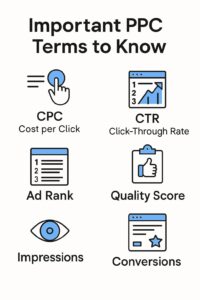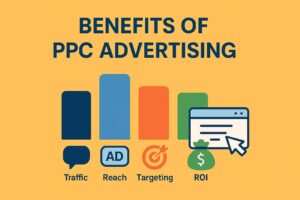PPC (Pay-Per-Click) advertising is one of the most powerful tools in the digital marketing world. It allows businesses to show their ads directly to potential customers and pay only when someone clicks on the ad. Whether you’re a business owner, marketer, or a beginner exploring digital marketing, understanding PPC can help you drive traffic, generate leads, and grow your brand online.
What is PPC Advertising?
PPC is a model of online advertising where advertisers pay each time a user clicks on their ad. It’s a way to buy visits to your website rather than earning them organically through SEO.
The most popular platform for PPC is Google Ads, followed by Bing Ads, Meta Ads (Facebook & Instagram), LinkedIn Ads, and others.
How PPC Works
1. Advertiser selects keywords relevant to their product or service.
2. They create an ad and bid on those keywords.
3. When someone searches for those keywords, the search engine displays the ad (if it wins the auction).
4. If the user clicks, the advertiser is charged a small amount (cost per click).
For example: If you bid ₹20 on “Buy Running Shoes” and someone clicks your ad, you pay ₹20 for that click, regardless of whether the user buys anything.
Key Platforms for PPC Advertising
Google Ads: Ads appear in Google Search, YouTube, Gmail, and partner sites.
Meta Ads: Facebook and Instagram PPC campaigns.
YouTube Ads: For video promotion and traffic.
LinkedIn Ads: Great for B2B and professional targeting.
Microsoft/Bing Ads: Often cheaper CPCs than Google.
Why PPC is Important
-
- Instant Visibility: Show up immediately at the top of search results.
- Targeted Reach: Focus on location, age, interests, device, and more.
- Pay for Results: Only pay when someone clicks your ad.
- Fast Data: Quickly test what works and what doesn’t.
- Boost Sales: Drive high-converting traffic to your site.
Important PPC Terms to Know

- CPC (Cost per Click): The amount paid when someone clicks your ad.
- CTR (Click-Through Rate): % of people who click your ad after seeing it.
- Ad Rank: Determines your ad’s position on the page.
- Quality Score: Google’s rating of your ad’s relevance and quality.
- Impressions: How many times your ad is shown.
- Conversions: Number of actions taken like form fill, sale, or sign-up.
- Keyword Match Types: Controls how closely a keyword must match a user’s search.
- Landing Page: The page users land on after clicking your ad.
Types of PPC Ads
1. Search Ads
-
- Text-based ads that appear on Google or Bing search results.
2. Display Ads
-
- Image or banner ads shown on websites part of the Google Display Network.
3. Shopping Ads
-
- Ads with product image, price, and link (great for e-commerce).
4. Video Ads
-
- Run on YouTube and are great for brand awareness.
5. App Promotion Ads
-
- Ads that drive users to download your app.
How to Create a PPC Campaign (Step-by-Step)
1. Choose your platform (e.g., Google Ads).
2. Define your campaign goal (sales, traffic, leads).
3. Select your audience (age, location, gender, etc.).
4. Do keyword research (use Google Keyword Planner).
5. Set a budget (daily or lifetime).
6. Create your ad copy (headlines, description, CTA).
7. Choose a landing page (make sure it’s relevant).
8. Launch your ad and monitor performance.
9. Optimize continuously based on data.
PPC Bidding Strategies
There are two main types:
-
- Manual Bidding: You control the maximum CPC for each keyword.
- Automated Bidding: Google sets bids based on your goals (e.g., maximize clicks, CPA, ROAS).
Choose the right strategy based on your goals, budget, and experience.
Common Mistakes to Avoid in PPC
-
- Targeting too broad an audience
- Using irrelevant keywords
- Poorly written ad copy
- Sending users to a weak or unrelated landing page
- Not tracking conversions
- Not testing and optimizing over time
Tips for Running a Successful PPC Campaign
- Use negative keywords to block irrelevant traffic.
- Write compelling headlines and clear call-to-actions.
- Optimize your landing page for conversions.
- Track everything with Google Analytics and conversion tracking.
- Test different ad versions (A/B Testing).
Benefits of PPC for Beginners

- Budget-friendly (you control how much you spend).
- Simple to track ROI (you know what you get).
- Easy to start (no coding or advanced skills needed).
- Scalable (start small, increase as you grow).
Conclusion
PPC advertising is one of the fastest ways to reach your target audience online. Whether you’re promoting a product, service, or personal brand, mastering PPC can give you a strong edge in the digital world. Start small, learn consistently, and optimize your campaigns to see real results.
Written by Priyanshi Jain
Delhi, India | digitalpriyanshi.com